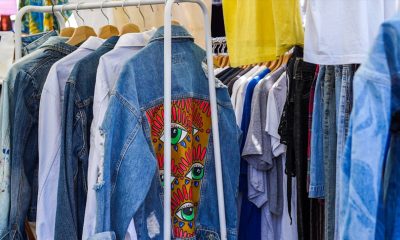Beauty & Fashion
Cruelty-free beauty products you need in your makeup bag
Becoming a vegetarian or vegan is not just about the diet, it’s about caring for animals. With that said, there are many more ways you can do your part to prevent animal cruelty without necessarily switching to a meat-free diet.

Becoming a vegetarian or vegan is not just about the diet, it’s about caring for animals. With that said, there are many more ways you can do your part to prevent animal cruelty without necessarily switching to a meat-free diet. All you need to do is check the labels on your makeup and toiletries, or just do your research, to see whether or not they’ve been tested on animals. If so, throw them out immediately and start buying cruelty free beauty products; most of which work just as well as other brands, and can suit any budget.
Here are a few suggestions to get you started.
NYX Cosmetics
Who said drugstore makeup can’t be cruelty free? NYX Cosmetics are easily found in most supermarkets and drugstores, and they don’t blow a massive hole in your budget. If you want anymore proof that these cosmetics are cruelty free, you should know that they are PETA certified. The range includes everything from eye shadows, lipsticks, concealers, and primers. You can find a basic selection in stores, or you can go to Amazon for the full collection.
The Body Shop
The Body Shop was the first global beauty brand to fight against animal testing in cosmetics. Most of their products are vegetarian, although you will find a few vegan cosmetics if you scan the labels to make sure there is no beeswax, honey, shellac, or lanolin in the product. Since vegan products are becoming more popular in an attempt to protect all animals, The Body Shop has launched a new vegan range, which will have a vegan symbol on them so they’re easier to find in shops. Ultimately, The Body Shop has always been dedicated to creating naturally inspired beauty products from the finest ethically-sourced ingredients. The range includes makeup, shower gels, skin care, and even hair care products.
Bare Minerals
For the people who don’t really enjoy wearing makeup, but feel the need to make an effort for a special occasion, Bare Minerals has managed to tick a lot of boxes. The original powder foundation has high praise for coverage, yet it doesn’t feel heavy like most other brands. The eye shadow powders look flawless, and are available in a wide range of colors. Bare Minerals is on PETA’s list of cruelty free brands, and this includes other brands such as Buxom, and MD Formulations, which are all part of the Bare Escentuals range. You can find them in high end shops in town, or you can look online for their full collection.
Wen Sixthirteen
There are many reasons to consider changing your hair products in addition to wanting a cruelty free shampoo. Most hair products are full of parabens and sulfates. Parabens are chemicals that have been used since the 1950s to prevent bacteria and act as a preservative in deodorants, lotions, lipsticks, shampoos, scrubs, and more. Sulfates are effective cleansing and foaming agents that can be found in toothpaste, shampoo, and body washes, among other products. Some studies have shown that some parabens can mimic the activity of estrogen in the body’s cells, and while estrogenic activity is associated with certain forms of breast cancer, parabens have been found present in breast tumors. Sulfates are concerning because they were found to break down proteins, which can lead to a degenerative effect on the cell membranes. Sulfates were also found to leave residue in the heart, lungs, and brain.
Although these studies have not been definitively proved, it does give you further incentive to switch your shampoos and conditioners. Wen Sixthirteen is technically a cleansing conditioner – a conditioner that is formulated to be used as a shampoo – but it works wonders on all hair types. It isn’t much more expensive than other specialty shampoo, not to mention you don’t need to buy a conditioner to go with it. With an option like this available, who needs to choose a shampoo that tests on animals.
Lush
Stepping into a Lush store is like entering a world of exotic smells. It’s all the more sweeter when you learn that everything in the store is handmade from raw materials, and none of said materials have ever been tested on animals. Lush never buys from any company that tests any products on animals, whether it’s for food, pharmaceuticals or cosmetics. Lush is mostly known for their luxurious bathroom products, but they also provide an amazing range of makeup, skin care products, and hair products. Their Cynthia Sylvia Stout shampoo is made from beer and cognac oil, which leaves all hair looking glossy. Lush can get a bit pricey, but you can buy some products by weight, so if you know you won’t need much you can still save a fair amount of money.
Natural perfumes
There are some people who dread perfume shopping, mostly because they can’t really distinguish one overwhelming scent from another. The majority of perfumes on the market today are made from positively damaging ingredients. The synthetic chemicals found in fragrances might make you smell good in the short term, but in the long term some of the ingredients can cause irritability, mental vagueness, muscle pain, asthma, joint aches, sinus pain, fatigue, eye irritation, gastrointestinal problems, dizziness, swollen lymph nodes, spikes in blood pressure, and burning or itching skin irritations. Perfume manufacturers are not required to list all their ingredients, but you should know that most perfumes are made with chemicals such as ethanol, acetone, benzyl alcohol, ethyl acetate, methylene chloride, a-terpineol, camphor, and limonene.
If you want to wear a lovely scent that won’t cause you bad long-term illnesses, you’re better off trying to find natural perfumes that don’t contain the same chemicals as air fresheners and laundry detergent.
Unlike cheap perfume scents created in labs, natural perfumes rely on scents found in nature, like essential oils and rare ingredients like ambergris (fossilized whale poop). When combined together, these scents create complex fragrances that tend to be less overwhelming than synthetic perfumes. Manufacturers of natural perfumes aren’t shy about listing their ingredients, so it might be easier to find one than you think.
Flower Beauty
The makeup line brought to us by Drew Barrymore features a lot of cheerful floral patterns and bright colors, which reflect the actress’ personality. You don’t have to be hesitant about buying this brand of celebrity makeup, because Barrymore’s company is cruelty free. PETA has confirmed that Flower Beauty does not conduct, commission, or pay for tests on animals anywhere in the world, therefore earning the right to display PETA’s logo on their products. The full collection of Flower Beauty can be found at Walmart, or online at the Flower Beauty website.
Nail polish
Nothing makes a person feel more glamorous and powerful than when they have a killer manicure. Unfortunately, not all nail polishes are created equal. Some cosmetics companies still pay for unnecessary and inhumane tests on animals. Some of these tests involve dripping substances into animals’ eyes, smearing products onto their shaved or scraped skin, or forcing them to ingest or inhale huge quantities of chemicals.
Fortunately, many cosmetics companies are filling this gap in the market. Brands such as Obsessive Compulsive Cosmetics, wet n wild, and Beauty Without Cruelty have released their own range of brightly colored nail polishes that do not test on animals. Beauty Without Cruelty makes their nail polish from plant-based ingredients, and also has a nail polish remover made from wheat, corn, and sugarcane, and it’s free from acetone and ethyl acetate.
Beauty & Fashion
Renting clothes for sustainable fashion – niche markets work best
The best chance of success is for a rental company to provide clothing within a niche market, such as specific sportswear, and to work closely with the suppliers and clothing manufacturers.

Renting clothes can reduce the fashion industry’s enormous environmental impact, but so far, the business models have not worked very well. The best chance of success is for a rental company to provide clothing within a niche market, such as specific sportswear, and to work closely with the suppliers and clothing manufacturers. This is shown by a study led by researchers at Chalmers University of Technology, Sweden, which highlights the measures that can make clothing rental a success.
The fashion industry is one of the most polluting industries and can account for up to ten percent of global greenhouse gas emissions, worldwide. In Sweden, over 90 percent of the clothes’ climate impact is linked to the purchase of newly produced goods. Therefore, researchers at Chalmers University of Technology, the University of Borås and the research institute Rise have examined alternative, more sustainable business models for the clothing industry.
“Many people have clothes hanging in the closet that are rarely or never used. Renting clothes can extend the use of each garment and thus contribute to more sustainable consumption,” says Frida Lind, Professor at Chalmers and one of the researchers behind the study.
In the study, the researchers analysed nine Swedish companies that have either tried and failed, or are ongoing in the process of creating a sustainable and desirable clothes rental company. From this analysis, the researchers identified three main business models for renting out clothes:
1. Membership model: customers become members and can then borrow clothes for a certain period of time, similar to a library. This model often had an enthusiast as its founder, with a focus on sustainable consumption.
2. Subscription model: customers pay a monthly fee to rent a certain number of garments. These startups worked on scaling up operations and attracting venture capital.
3. Individual rental model: the company would provide specific types of clothing to rent out, often in combination with other equipment, such as outdoor clothing paired with ski equipment.
Difficult to achieve profitability
By interviewing founders, managers and other key people from the nine Swedish companies, the researchers gained an understanding of each company’s situation.
“What struck us was that it seemed so difficult for them to make their business profitable. Several had had to end their investments for various reasons,” she says.
The researchers noted that although there was a willing customer base for renting clothing in this way, they observed several other challenges that made it difficult for companies to achieve profitability.
“Renting out clothes involves many steps where each item of clothing needs to be handled and inspected before it can be rented out again, which takes time. Companies also struggled with high costs for warehousing, logistics and laundry, for example. Especially for the subscription models, there were also difficulties in obtaining venture capital to be able to survive financially through the first phase of building the company. All this shows that these business models need time to establish themselves in the market,” she says.
Specific markets performed best
At the same time, some of the business models worked better than others. Companies that focused on a specific market, such as outdoor clothing, were more successful and sustainable. Especially if they also had a local connection to an outdoor recreational area.
“They seem to have found their niche and seen that there is a specific need that the customer is willing to pay for each time they need to use that type of clothing,” says Frida Lind.
The researchers also examined how the companies created value in collaboration with different stakeholders and concluded that certain collaborations were particularly valuable.
“Rental companies that worked closely with clothing manufacturers and suppliers, such as designers with a sustainability profile, benefited greatly from this as they were able to quickly get feedback on which types of clothing were most popular. They also gained valuable information about the quality of the garments, for example if there was something that often broke,” she says.
Initiatives for change important
In the current study, the researchers have not investigated the environmental and climate impact of the business models specifically, but in general, the environmental effects of our clothes have already been well mapped. For example, previous research from Chalmers has shown that the actual production of garments accounts for 70 percent of the climate impact of Swedes’ clothes throughout their life cycle, and 22 percent of the climate impact is caused by customers’ shopping trips. In the European Union, five million tonnes of clothing are discarded each year – around 12 kilos per person, and in the USA, the average American generates 37 kilos of textile waste each year.
Frida Lind believes that there is a great deal of room for environmental benefits through reduced clothing purchases and extended use of existing garments – especially if it can be done without extra car journeys for consumers.
She emphasises that even if some of the companies and services in the study have not survived, all initiatives that can contribute to the sustainability transition are important. Not least because they help to change attitudes about clothing consumption and increase knowledge about what can and cannot work.
“Our study can be an important contribution to the fashion industry’s sustainability transition, as it shows the possibilities of new business models in this industry. We hope that it can have an impact on decision-makers who need a basis for establishing incentives and financial motivation for a more sustainable fashion industry. Because we see that new and more sustainable business models require time and a long-term perspective to be able to establish themselves,” she says.
Recommendations for the industry
Based on the study’s results, the researchers give a number of recommendations to those who intend to try renting clothes as a business model:
- Focus on niche markets based on target group and product type where the need is clear
- Develop partnerships with suppliers to improve products based on rental experiences.
- Think about logistics and transport in the rental model right from the start to be able to get the model scalable.
More about the research
The scientific article “Exploring renting models for clothing items – resource interaction for value creation” was published in the Journal of Business & Industrial Marketing. The authors are Frida Lind, Chalmers University of Technology, Agnes Andersson Wänström and Daniel Hjelmgren, University of Borås, and Maria Landqvist, Rise. The study has been financed with funds from the Swedish Energy Agency.
Facts and advice about textile consumption
- In the European Union, five million tonnes of clothing are discarded each year – around 12 kilos per person, and in the USA, the average American generates 37 kilos of textile waste each year.
- Over 90 percent of the total climate impact from Swedish clothing consumption is linked to the purchase of newly produced clothes, and 80 percent of our clothes’ climate impact occurs during the production phase.
- It also plays a big role how customers get to the stores. If they walk or cycle instead of driving, they reduce their climate impact by over 10 percent.
- The most important thing that consumers can do is to extend the use of the garments that have already been produced. A t-shirt, for example, is used an average of 30 times. If it is instead used 60 times before it is replaced by a newly produced t-shirt, the climate impact can be halved.
- Extended use can mean that one owner uses the garment for longer, or that several users share ownership. In addition to renting or borrowing clothes, this can be done, for example, by shopping and selling second-hand, arranging clothes swap days or giving away clothes to someone who continues to use them.
- A previous Chalmers study has shown that the actual production of garments accounts for 70 percent of the climate impact of Swedes’ clothes throughout their life cycle. 22 per cent of the climate impact is caused by customers’ shopping trips, 4 per cent by distribution to customers and 3 per cent by washing and drying clothes.
Beauty & Fashion
Sassa opens standalone store in Festival Mall
Compared to traditional department store counters, the standalone store provides more space, better privacy, and a more relaxed shopping experience. Customers can now enjoy a wide selection of styles, with more options to mix and match. The open layout also makes it easier to try on pieces and do personal styling sessions with comfort and convenience.

Located on the Upper Ground Floor of Festival Mall’s West Wing the store features a vibrant, modern space that showcases Sassa’s full lifestyle range—from swimwear and activewear to intimate wear. With bold blue accents, clean lighting, and organized display zones, the store offers a fresh, inviting atmosphere for every Sassa Girl.
Compared to traditional department store counters, the standalone store provides more space, better privacy, and a more relaxed shopping experience. Customers can now enjoy a wide selection of styles, with more options to mix and match. The open layout also makes it easier to try on pieces and do personal styling sessions with comfort and convenience.
For the first time, Sassa brings together all its core collections in one space—designed not just for shopping, but to create a closer, more meaningful connection with the women it was made for.
A Strategic Step Closer to Every Filipina
Recognizing the need to connect more closely with its growing community, Sassa opened its very first standalone store as a way to bring the brand experience directly to its customers—outside the usual department store setup.
“This store is more than just a physical space—it’s a statement of who we are and how far we’ve come,” shares Raiza Limpiada, Marketing & Ecommerce Manager of Sassa. “After more than two decades of being mainly found in department stores, we wanted to create a space that brings us closer to the Filipina—somewhere she can truly feel what Sassa is all about. We’re not just a local brand anymore—we’re becoming a true lifestyle partner.”
After a remarkably strong year of double-digit growth, Sassa is excited about what’s ahead with the opening of its Festival Mall store. The brand is aiming for a 40-50% boost in sales compared to its usual numbers. More importantly, it looks forward to seeing customers spend more time exploring the space, discovering new favorites, and enjoying a more personal shopping experience—all part of Sassa’s journey to grow and connect more deeply with Filipinas in the local fashion scene.
“Our goal is simple,” Raiza adds. “We want to build real relationships, make every visit memorable, and grow alongside our customers. This store is just the beginning.”
Unveiling the Latest Retail Experience
To celebrate this milestone, Sassa hosted a grand opening event attended by brand executives and loyal fans. The festivities included a ribbon-cutting ceremony, store tours, and exclusive first-day offers—creating a memorable experience for early shoppers.
Guests enjoyed limited-time promos, gift-with-purchase deals, and a sneak peek at exclusive styles available only at the Festival Mall store—highlighting the brand’s move toward a more stylish, personalized approach.
With more standalone locations planned, Sassa Festival Mall is just the start. As the brand grows alongside its community, it remains committed to helping every Filipina feel confident and stylish—wherever they go, whatever they do, and in every aspect of their lifestyle.
Experience the Sassa difference for yourself—visit our new Festival Mall store today! Follow @sassa_ph on Instagram and @sassa.ph on Facebook and TikTok for updates.
Beauty & Fashion
Posh Skin Co. launches new pimple patch designs
Posh Skin Co. reinforces its commitment to making acne skin solutions more accessible, fun, and confidence-boosting than ever as it launches new designs of its innovative pimple patches.

Posh Skin Co. levels up its skincare game as it steps into a new era with a clean new look. With this fresh transformation, Posh Skin Co. reinforces its commitment to making acne skin solutions more accessible, fun, and confidence-boosting than ever as it launches new designs of its innovative pimple patches.
Trendy, Effective, and Fun Pimple Patch Designs
Posh Skin Co.’s rebrand also brings in a new lineup of pimple patch designs, crafted to meet different skincare needs while offering a fresh and fashionable take on blemish care. The new designs include yellow star patches, multicolored star patches, metallic foil patches, for a fun, and comfortable acne treatment experience that lasts all day. The ultra-thin daytime patches provide a discreet and seamless coverage for all-day wear, while the nighttime rescue patches are designed to accelerate blemish healing while you sleep.
The pimple patches now come in new packaging with a sleeker, more minimalist look, following Posh Skin Co.’s rebrand.
“We took on a cleaner and simpler packaging approach to let the pimple patch designs speak for themselves,” said renowned fashion stylist and Posh Skin Co. partner, Charmaine Palermo. “We wanted to highlight what truly matters—effective skincare that empowers people.”
Formulated with the same powerful ingredients, these new pimple patch designs offer users improved coverage, comfort, and effectiveness, and make acne care more wearable and confidence-boosting than ever.
A Fresh, New Chapter
Posh Skin Co.’s new look aligns with the brand’s vision of expansion in the Philippines. Not only is Posh Skin Co. adding new designs to its pimple patch offerings but will also be providing new, versatile acne solutions that fit effortlessly into any lifestyle.
“Acne care should be as dynamic as people’s lives because breakouts can happen at any time,” remarked Palermo. “We wanted to offer more options to treat and prevent breakouts effectively, so we are expanding our line with acne solutions that can easily integrate into any skincare routine.”
With inclusivity and accessibility still at the brand’s core, Posh Skin Co. ensures that the skin treatment they offer will still be a stress-free and empowering experience for all users. As it broadens its pimple patch offerings and develops new skin treatment solutions, Posh Skin Co. continues to deliver innovative skincare to Filipinos.
Say “Bye” to Blemishes, and “Hello” to Confidence with Posh Skin Co.® Pimple Patches
Look good and feel confident while treating your blemishes with Posh Skin Co. pimple patches, available for PHP199 on Shopee, Lazada, TikTok Shop, and the official Posh Skin Co. website and select Watsons stores nationwide.
-

 Product Showcase3 weeks ago
Product Showcase3 weeks agoManulife Philippines ‘Time to MOVE’ symposium focuses on health and longevity
-

 NewsMakers1 week ago
NewsMakers1 week agoMillennials and Gen Zs prioritize health, purpose, financial independence, but health and wellness gaps persist
-

 Product Showcase1 week ago
Product Showcase1 week agoKorean brand Wells showcases 23 years of engineering innovation
-

 Product Showcase1 week ago
Product Showcase1 week agoAIA Philippines CEO named Executive Champion of the Year in Asia
-

 Destinations2 weeks ago
Destinations2 weeks agoChecking religious expression at Montemaria in Batangas
-

 Destinations3 weeks ago
Destinations3 weeks agoBeach-hunting led to Malabrigo Beach
-

 Product Showcase4 days ago
Product Showcase4 days agoManulife brings personalized gut health insights to PH
-

 Destinations4 days ago
Destinations4 days agoChecking out Street Halo-Halo Milky Ice

















